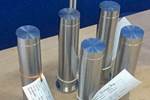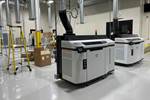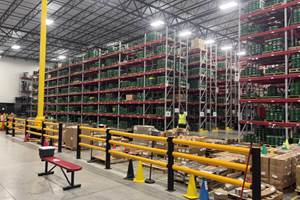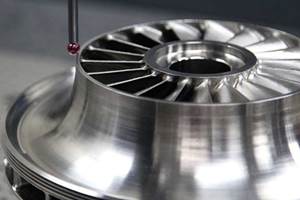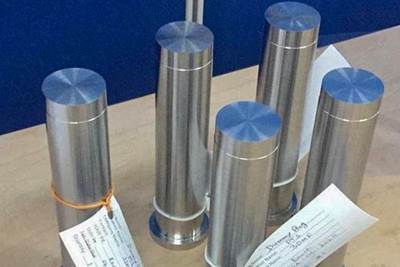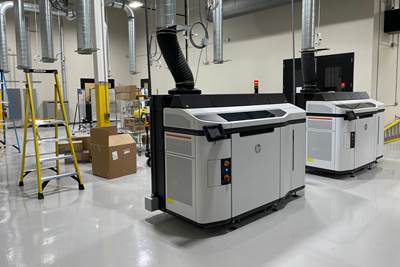3D Printing for Supply Chain Resiliency: AM Radio #39
Additive manufacturing can speed, strengthen and simplify industrial supply chains. How close are we to realizing this promise? Dr. Tim Simpson and Peter Zelinski discuss lead time, logistics and other factors on AM Radio.
Additive manufacturing offers significant promise for strengthening and simplifying manufacturing supply chains. We glimpsed this during the pandemic, when 3D printers provided a quick response for needed medical components for uses such as ventilators and personal protective equipment. What are the ways AM can answer supply chain problems longer term, and how close are we to realizing this promise? In this episode of the AM Radio podcast, I am joined by Penn State’s Dr. Tim Simpson as we discuss additive manufacturing as a logistics solution, 3D printing for faster lead time relative to casting and forging, AM for MRO and sustainment needs, and other aspects of additive as a supply chain solution.
Transcript
Peter Zelinski 00:04
Manufacturing supply chains. The topic we've been hearing a lot about in the last couple years, a topic with a lot of problems and additive manufacturing offers some of the answers. Talking about supply chain resiliency on this episode of AM Radio.
Jodee McElfresh 00:27
This episode of AM Radio is brought to you by Formnext Forum Austin, the first of a series of Formnext events coming to the United States. Find more information at formnextforum.com.
Peter Zelinski 00:41
Welcome to AM Radio, our show where we tune in to what's happening in additive manufacturing. I'm Pete Zelinski with Additive Manufacturing Media, I'm joined by Tim Simpson, professor of additive manufacturing at Penn State University. Hi, Tim.
Tim Simpson 00:55
Hey, Pete.
Peter Zelinski 00:56
Great to have you back.
Tim Simpson 00:57
Thanks. Great to be here.
Peter Zelinski 00:58
So Tim Simpson has joined the Additive Manufacturing Radio team. And in each of the episodes when he appears, it is this chance to look at topics we think a lot about through different perspectives. Tim's a user of additive, teacher, a researcher, and we here on Additive Manufacturing Media, we're writers, observers, and we're looking at the same stuff, but maybe coming up with different thoughts about it. I think, Tim, like an example of one of these really big topics I want to try to open up and look at today is the supply chain.
Tim Simpson 01:35
Yeah, sounds good. I think seeing regular updates on how additive is going to make our supply chain more resilient, less, you know, be less disrupted all these sorts of aspects. So a lot of hype out there. But same time, certainly some advantages and opportunities where additive can help.
Peter Zelinski 01:53
Okay, so supply chains. This big term, I think almost anyone in and near manufacturing knows what that term refers to, except exactly what that term refers to, can be hard to pin down. Big topic, like I say, and something big about it seemed to break within the last few years. And I don't think we can get back to exactly the situation that we had before. And the disruption and the challenges we've discovered with supply chains are something we can't 3D print our way out of, but additive offers part of the answer. Like maybe a starting point is just riff however you'd like to, but talk about, why are we talking about this, the supply chain, supply chains, what happened?
Tim Simpson 02:45
Supply chain is one of those topics everybody's sort of familiar with, they kind of know what you're talking about, at least at sort of the abstract level. And it's also one of those things where if the supply chain is working, well, nobody really notices or nobody takes note, because my, my shoes, my parts, my groceries, my airplanes, right, are all showing up at the right place at the right time. And everybody is then really competing on, primarily on cost, if everything's being delivered where it needs to be when it needs to be and performing as it needs to be, then the competition is really about how, you know, how cost effectively can I make that so I improve efficiencies and faster delivery and do it at less cost, whatever the case may be. I think what happened during the pandemic is all of a sudden you, you know, just because you placed an order for something doesn't mean that it showed up at your doorstep or your factory floor or wherever. And whether that was PPE, personal protective equipment, you know, masks and shields and things or even after the pandemic, right, could we, auto manufacturers, were there are enough chips for automobiles that then led to supply chain? I think one of my favorite was the first Thanksgiving during the pandemic, there were not enough small turkeys. And we had a shortage of turkeys because why? Well, we were used to family gatherings with lots of people that required big turkeys. And so all of a sudden everybody wanted small turkeys because they were home with less people because we couldn't travel and guess what the farmers in the supply chain weren't ready to deliver and have enough small turkeys in town at the local grocery store. So you know, we were all feeling pinches here and there and everywhere when, when the supply chain wasn't working properly. And fortunately additive manufacturing, one of the silver linings of the pandemic was additive became useful in all sorts of ways that those of us in the additive community know and talk about and realize, but the rest of the world hadn't, wasn't familiar with, hadn't put into practice and all of a sudden saw additive in a new light.
Peter Zelinski 03:32
All right, there's a lot in there. So that's, that's the pandemic did a couple things the way you're describing it, you're right like it's, it wasn't just the the lockdowns keeping people away from manufacturing facilities. But then it was also the demand and the kinds of things we wanted suddenly changed. And both of those things together, as you say, made the supply chain visible. It was invisible before and and it, it taught us that we, we don't want just one thing, we actually want two different things. We don't just want a product at the right price, we want it at the right time, too, the right time was something we could take for granted before the pandemic. The silver lining, you're describing, the way additive stepped in, it, it stepped in, in kind of organic, crowdsourced and clumsy ways at first, when it first started responding. The 3D printed small turkeys were a bust, I think we can all agree on that. But it's stepped into PPE. And I'm not sure that 3D printing provided a great solution for PPE, but it provided a timely solution when that's what was needed. You were involved in that, Tim, your your group at Penn State, you were 3D printing PPE. Yeah, and, and that change is huge. That was, that was a huge pivot that began in the pandemic, and I'm seeing it play out significantly right now. And it's this change from additive as primarily or even almost solely a design solution becoming a manufacturing and logistics solution. And so, in, in that first framing of additive, it's additive competing with assembly or, or additive competing against the design limitations that other processes impose. Whereas now, in, there are succeeding additive manufacturing applications where no significant design change is being called for in the part being made, but the delivery and tracking and storage methodology is changing significantly. So here, it's, so on the one hand, it was additive as an alternative to assembly. Now, we're seeing additive competing against trucks and warehouses. And that's huge.
Tim Simpson 06:18
We were, yeah, during the pandemic, I found myself leading a large team trying to support Penn State Health, College of Medicine, several local hospitals, nursing homes, etc., just to address this PPE shortage. And I think additive, for me, what really changed in the pandemic was, as we were trying to help health care workers and other individuals, it became very clear that the you know, buying the lowest cost item or sourcing the lowest cost item wasn't necessarily the best decision. Because if it was then stuck on a boat trying to cross the Atlantic or somewhere else, we weren't going to get those parts or components anymore. And so we had to shift our thinking to how do we source locally and regionally to be able to address this. And that's where additive sort of started showing its true colors. And I think the big change that I saw is most of us think about when we talk about additive and when you're, when you're highlighting examples, it's on the design aspects and the design freedoms, right? So it's additive has been and if you think about when, when rapid prototyping and 3D printed first started, it was, it found a good niche, it was able to deliver a solution for designers and engineers, I'm able to rapidly prototype a part, now I can see it, feel it, touch it. During the pandemic, though, additive manufacturing became a solution for manufacturing. And whether it was stop gap production, right? Hey, this isn't, this isn't the cheapest way to make this part. But if I can make something until the parts get here, that's great. Let me, I'm having trouble getting fixtures, dyes, tooling, or other aspects. There were all of these sort of valuable uses of additive manufacturing in manufacturing and to support manufacturing that I think has really since changed people's perceptions of additive manufacturing now post-pandemic. Right? If I can send my data anywhere to make the part locally, then I don't have to ship it. I don't have to fly it. I don't have to truck it or put it on rail cars or whatever. And so you definitely see that and, again, I get as you were talking it made me think of an example. You know, vent, ventilators right were so critical during the pandemic time, you mean, you were looking at companies completely overhauling their manufacturing line to make more ventilators and things given, given the challenges and the need to intubate patients and stuff at the early stages of the pandemic. We actually went through and looked at the inventory, this was down at some of our hospitals there, trying to say, Well, what, which of the critical components, right? Every patient? Oh, well, we've got to change out this part, this part, this part and this part, oh shoot, we're low on, we don't have enough of those in the closet anymore. If we can't get that part, you know, the the mechanical parts of the ventilator work, but I can't hook it up to the patient. So now what am I going to do, right? And so we were able to, in some of those cases, actually, you know, use additive manufacturing, 3D printing, we found a company 3D Systems out in Colorado, right, had FDA-approved processes and things that if we needed those parts, we could get them made, and then produced back to us until the actual replacement components showed up. And you're seeing this, this has been going on, for instance, in the Department of Defense has been doing this for a long time now, right, this notion of, of MRO and sustainment, right, maintenance, repair and operation, I've got these systems that have been out in the field or planes that have been flying for 30, 40, 50 years, you know, the original manufacturer doesn't exist anymore, I can't get the replacement parts. So can we use additive? Because you think about, okay, I can't get the patient on this ventilator? Well, you know, if I'm out in the field, or in theater somewhere, and my, you know, vehicle breaks down, you know, I gotta stay in protected, I can't get my troops back safely, or whatever the case may be. And so additive is seeing lots of interest in those domains as well to sort of do on demand, you know, printing functional components just to, you know, bring the vehicle back to base safely, and then we can repair it. And so there it's, it's a manufacturing solution to provide replacement parts or a stop gap component until the traditionally made or traditionally sourced one can arrive.
Peter Zelinski 11:44
Yeah, that's right. We've been, we've been connecting this change to the pandemic, but, but it's a change that probably would have happened anyway. The silver lining of the pandemic, maybe is that this benefit of, of additive manufacturing got kickstarted, and we're years ahead of where we might otherwise be. But there were other sectors and segments and applications that were struggling with lead times previously. And I'm thinking of how long the wait times were extending for castings and forgings. And, and we were seeing, like, I think going back years, we were already seeing the conversations about maybe the part doesn't give you forging-like properties, but is there a way to validate and accept the part anyway? Because the 3D printed alternative gives you such better flexibility and, and lead time responsiveness?
Tim Simpson 12:40
Yeah, I agree with you, I think we would have gotten there anyway, but I think the pandemic accelerated this, right, which is where now it's, it's much more prevalent. And to your point, you know, forgings, that, take 18 months was driving a lot of aerospace component manufacturers to look at alternative means of making their components and additive, you know, has, has shined in many of those applications. You know, I think the other point you raise there, right, it is about lead time. And so in situations where lead time is critical, I mean, obviously, everybody jokes, right, time is money. But in this case, if the lead time is so long, I'm never gonna get my part or I can't get it any more then I'm willing to pay a little more money to get it a different way. And so, you know, additive still from a cost perspective, right, the prices have been coming down within additive manufacturing, material machines and other aspects there and a lot of advancements that are going on. But, doing that direct head-to-head comparison, as we've talked about previously, the additive part will often be more expensive, but if I can't get the conventional part any other way, perhaps I'll pay 10% more 20% more, so I can have that component and get to work. And I've seen that as well in some aerospace companies where the conventionally made part couldn't get there in time. And it basically, it was stopping a testing program where they were spending millions of dollars sitting around twiddling their thumbs waiting for that part to show up to put it in the assembly to then go off and, you know, fire it up and test it. And so, you know, there are situations where that lead time is critical for it. And that's what additive has been really helping with in manufacturing. So, using additive to reduce lead time, whether it be on the factory floor, whether it be in testing, whether it be in prototyping or development, right, I think that's been one of the other advantages people are starting to realize is with additive, you can now control the critical path, for example, and so I can now print functional components and quick, more quickly iterate on designs even if I may not be producing them using additive manufacturing in the end, like we were doing face masks during the pandemic and you look at, you know, so we were sending new designs down to the doctors at, at Hershey, you know, every other day, here's, here's the next six or seven iterations, right? Try it on, let us know what works. But then when you stopped and looked at, oh, if I actually want to produce this mask, in the quantities that are needed in the time that's needed, I joked, I'd have to fill up, I'd have to fill up our football stadium with 3D printers to keep up with that. So, at some point, we then naturally shifted say, Okay, well, the doctors you've got, you've got 20 masks that can can help for now. Meanwhile, let's start looking at tooling and connecting with, you know, tool and dye manufacturers up in Erie where there's still a plastic, you know, a lot of plastics engineering expertise, as we shift to injection molding, and now do we need to tweak the design a little bit, right? So you need to, even though it may be this good stop gap at different stages at the end of the day, though, you still need to look at well, what is the cost? What is the time? What is the quality, right? That still holds? Requirements are still requirements, physics are still physics, additive doesn't change any of that as well, and it still needs to meet those requirements and be delivered on time and on cost at the end of the day. But, the pandemic and this discussion around supply chain disruptions is that we're finding new and creative ways to attack those things with additive manufacturing and finding wins. I mean, you look at, for instance, some of the challenges we were talking about with casting, right, how long is it taking my, I don't have the patterns anymore, so how long is it going to take to get a mold, to get my, get my sand casting to pour my part? Well, now I think there's the industry there, I think is really being transformed by 3D sand printing. So, I'm using additive indirectly, to then be able to make the molds to then do traditional sand casting, for example, in metal casting, so, but now I can get the patterns wherever and, and actually, I can make better molds, the screws, the gates, the riser, some of the work my colleague Guha Manogharan's been doing here at Penn State, right, we can now use and optimize the flow of the molten metal to actually make a better casting with a 3D printed sand mold than we could with traditional. And, when you start looking at that and saying, Hey, additive can help me reduce defects by like 95 to 99% in my casting, you're like, what, why are we not doing this? Right? You look at, Oh, well, I can get my fixtures printed in a day. Oh, I can reduce, you know, you look at I've seen some good stories of Volvo using fixtures for, you know, on the manufacturing line and custom tooling. I can get these turned around in days versus weeks, and save, you know, significant amount of time, 20%, 30% reductions in time or cost on the line. Holy cow. That's a huge savings. Why are we not jumping up and down celebrating that, right? And that's part of what we're now realizing is that the broader manufacturing community is now starting to see those benefits and realize, whoa, it's, it's not a half a percent or a 1% it's, it's a 10%, it's a 30%, it's a 50% savings in time, in cost that enables me to do this, that's actually reducing, better alignment of components during assembly that's basically then reducing fatigue on the worker, bam, bam, bam, all these other benefits that is really changing the discussion about what what and where and how additive can be used, you know, in manufacturing, on the shop floor, during production, in the factory, you name it.
Peter Zelinski 18:30
Changing the conversation about what and where and how we produce, additive manufacturing finding its wins, yeah, in the supply chain challenges additive manufacturing is an answer. It's not the whole answer. But, the ways that we're thinking about supply chains are changing. I guess after the break, Tim, we've been talking in big ideas, in generalities here, let's get specific and talk about present day, real life, some examples of supply chain transformations we've seen using 3D printing.
Jodee McElfresh 19:05
This episode of AM Radio is brought to you by Formnext Forum Austin, a new Formnext event coming to the US this summer. The conference and expo is organized by Mesago Messe Frankfurt, AMT, the Association for Manufacturing Technology, and Gardner Business Media, the publisher of Additive Manufacturing Media. Formnext Forum Austin is designed for leaders and owners of manufacturing enterprises, including companies already advancing with additive and those getting ready to adopt it. It's also for engineers engaging with additive technology, and researchers who are advancing what is possible for AM to do. The conference program offers three tracks: Production, powered by The Cool Parts Show; Design for Additive Manufacturing, powered by CIMP-3D; and, Technology, powered by Additive Manufacturing Media. The event also includes an expo featuring AM technology tours of local additive manufacturers and plenty of networking opportunities. And don't miss the finalists of The Cool Parts Showcase, a contest highlighting innovative 3D printed parts. Join Additive Manufacturing Media for Formnext Forum, August 28 through the 30 in Austin, Texas. Find more information about exhibiting, attending or sponsoring this event at formnextforum.com.
Peter Zelinski 20:25
Welcome back, Pete Zelinski. Talking to Tim Simpson, we're talking about supply chains, supply chain resiliency, the role that additive manufacturing is finding and has found. Tim, when we were talking before the break, one of the applications you mentioned is military depots. Does an example come to mind of a supply chain transformation that you've seen there?
Tim Simpson 20:51
There's been a lot of interest in the DOD side of looking at where and how should we place 3D printing and additive manufacturing capabilities, right, at the depots on board ships, in theater, you know, forward expeditionary units and those sorts of things. And there have been several good examples. I know Army, Navy and Air Force and Marines, as well, that have been able to find direct benefits and uses. We've been involved through the applied research lab here. Greg Welsh that was previously at NAVAIR was doing some work. We talked about the link and fitting that was really a pathfinder part more than a supply chain logistics issue, but you've certainly seen the T-44 Pegasus. FRC East was able to use 3D printing to recreate an air duct tubing that they were not able to get any other way, right. The original equipment manufacturer wasn't out there and those sorts of things. So, using Ultem to be able to do that, and then one of mine, you know, Liz, Liz McMichael has been a huge proponent for additive across and within the Navy there, and John Schmersal, as well. We've worked with them. Looking at, now, how do we distribute these manufacturing capabilities across different depots and different bases? And there was actually an issue with the the onboard oxygen system on the T-45 Goshawk, where basically, the pilots and training was grounded for several months back in 2017 because they couldn't, you know, breathe and get the right amount of oxygen in the cabin air. And so they were able to, the Navy was then able to manufacture 300 valves over the course of about two weeks across six different sites, right. So they had already deployed 3D printing capabilities. And basically, were able to leverage distributed manufacturing, based on your local capacity, print a bunch of these valves, ship them all. And voila, they were able to then get the pilots back up in the air, doing the testing and training very quickly, so, and these have all been great, you know, great cases and examples that are now out there that I hopefully will talk about and see more of going forward.
Peter Zelinski 23:04
The thing about depot applications, service part applications in general, it is, it's a need that is on the far back end of a component's life, it is, with, the thing with legacy parts, tooling goes obsolete, suppliers maybe go out of business, inventories that are in storage run out, we can discover supply chain gaps over time where it just doesn't make a lot of sense to ramp back up a production process or reinvent a tool to make what might need to be a few components. It's this back end, this back end need, and I guess what I connect that to and what I think of, something we mentioned briefly in the first half of the show, but there's almost a parallel and symmetrical front end demand that additive can speak to, to just that moment when the process hasn't ramped up yet, or you're waiting for the tooling, like, like additive doesn't have to solve the entire supply chain problem. It can solve emergencies where they come. Bridge production is the way, is the term we found to refer to this, I guess an example that comes to mind, GM and the, their Chevy Tahoe the moment came where I guess very late in the marketing of this vehicle, before it was launched, the fuel efficiency, the specific fuel efficiency it had to attain changed and GM could get there by adding this new extra flexible seal to part of the back end of the vehicle, and it was going to be this long wait to get mold tooling and the part eventually would be molded and is being molded, but in the meantime, GM turned to 3D printing and 3D printing and TPU to make these flexible seals. Another example of a part where there was no particular design change for additive as far as I, I know, it's the same component that would otherwise be molded, but it was made in this TPU from BASF. GKN was the contract manufacturer, they produced it through Multi Jet Fusion on HP machines. And I believe something like 60,000 of these seals were produced through 3D printing, to bridge through until the tooling came, and the more conventional process could come online.
Tim Simpson 25:27
Yeah, great example there. And I think that was a lot of what we saw in, again, during the pandemic, right, is essentially we're bridging production until, you know, the mass manufacturing of masks, face shields, you know, whatever the case, whatever the case was, could come online. And to your point, actually, if you, recently just was published, a three year study was done. The Army with their AMNOW program, A-M-N-O-W, right, just looked at the capabilities of a digital additive supply chain. And so this was work that came out of NCDMM, Kevin Slattery from The Barnes Global Advisors was our technical lead, was, he was driving this and really looked at the whole whole process, right? How do we create technical data packages that we can send securely? How do we source materials? How do we manufacture? How do we test, and these were metal components, right? So these were looking at real Army needs, use cases and application both for production and sustainment, and be able to then look at a wide variety of different use cases, and applications going forward. So that, that story was literally just recently released And we'll put a link with the show for people that want to dig into that more as well. But that's now other organizations, DOD and otherwise are looking to that saying, Oh, my goodness, here's an example, we took additive, additive is you know, is a digital technology. So how can we use, create a digital supply chain? What does that look like? And it goes back to an earlier point that you mentioned, right? The supply chain is invisible until it's broken. And when you're in and now talking to people in the supply chain, everybody wants to talk about supply chain transparency, they want to be able to see into the supply chain. And so if we now have a digital supply chain, well, what does that do in terms of transparency? Where's, where does my material originate? My part originate? Where does it go? Where does it get assembled? Where does it get used? And now if everything is digital, let's leverage the digital twin digital threads, create digital dashboards to be able to look at this all in real time. So I've got almost, you know, a heads up display, if you will, on where's where's my part? Where is it in this process? Where's my material coming in? Where, what's on the truck to be delivered, etc. And so I think it's exciting, you know, additive isn't the end all and be all and won't be the only solution, but I think it's really starting to drive these discussions about what does and can digital look like? Where additive is the current capability, but there's all these other technologies for manufacturing that are now being brought to bear, particularly robotics and automation, among others. Oh, what's the digital twin? What's the digital thread? What's the digital factory? And how do I leverage all of this and create? You know, I like to use the example of Google Maps, right? Think about what now as, as our cell phones are basically providing IoT devices to tell us where our cars are going, so I can get better driving instructions to reduce my time to get somewhere? Can I create this equivalent in a manufacturing supply chain environment? Where are all my parts moving through this network? Where now I'm getting signals from, from the processes, from the factories, from the parts, from, from the the consumers' use of them, right? So think about smart products now, that are able to gather this data during use and feed that back to now improve the design going forward? And so can we tie those end users, Oh, my parts, this component is breaking down a lot and needs to be repaired a lot in the field? Oh, how do I feed that information forward to then be able to design it better going forward? Or how can I use additive to embed sensors to get the data to design better components or prevent a failure in the field? So there's just all sorts of ways that additive can enable new digital capabilities within the entire supply chain that we're just now starting to realize to tap into and realize the potential benefits there.
Peter Zelinski 29:38
Additive is not the requirement for a more digital supply chain, but, but I guess whatI think about when additive is the production process in a digital supply chain, when the digital supply chain uses digital manufacturing, one of the promises we get out of that is distributed manufacturing. Like let's talk about that a little bit, the, if you are utterly free from hard tooling, then, in theory, sending manufacturing somewhere else is just an email, just sending the data to the other facility. It's a little harder than that. Like, there's a devil in the details aspect of that. I mentioned GKN earlier. GKN, contract manufacturer using 3D printing, using Multi Jet Fusion, using the same capabilities and multiple facilities. They've got a, a Carlsbad, California facility, and have ramped up this facility in Auburn Hills, Michigan, but talking to them, learning about the challenges that go into really getting distributed manufacturing, even when the platforms are identical. Like, for example, California and Michigan, different climates, different temperatures, different humidities, and their initial steps with trying to get a freely distributable process involved understanding those effects and learning how to calibrate for those effects. Do you know what's another one is ITAR certification, as it happens, one of their facilities is ITAR certified and another, the other one isn't, so that right there inherently affects what kind of work can be distributed.
Tim Simpson 31:12
Absolutely. And some companies have gotten in trouble for sharing ITAR data inadvertently within supply chains, right? So, I think, I think that's a challenge now is, Oh, it's easy to email this to wherever for them to print it. It's like, whoa, what are we actually printing? What are we making? So ITAR is one issue, then you can think also about liability, right? If you, somebody else is producing it now on your behalf, who then becomes liable for the print or the part should it fail? As things are then, you know, exports and imports, right? Are we able to levy taxes and or other things on parts where we're importing the data, say, across borders versus the parts? What does that mean in terms of tariffs and whatnot? So it creates a whole, whole new set of challenges, but it certainly is making us think differently about how do we evaluate and assess and ensure that quality parts, components are being delivered, as we said earlier, at the right place, at the right time, that making sure that things are not going to inadvertently fail or something else will go wrong.
Peter Zelinski 32:21
There's a great success of this IMI Critical Engineering demonstrated, they use laser powder bed fusion machines from Velo 3D, and to demonstrate the international distributed manufacturing you're describing, they simultaneously successfully 3D printed the same identical choke valve component in, I think it was four US locations plus one in Austria and one in South Korea. And it's, and it demonstrates that, yeah, devil's in the details, but you can calibrate and normalize sufficiently that you can get good integrity of production instantaneously by shifting, shifting data around digitally. The big hopeful beneficiary of this that I've spoken to recently is, is the oil and gas industry. And because they inherently, in their business, they operate not only internationally in different parts of the world, but in some of the most difficult parts of the world. And like they, oil and gas gets drilled where it is in the earth, and it's a demanding operation that has, involves a lot of replacement parts, a lot of which have high lead times and the oil and gas industry deals with this just by keeping billions of dollars of spare parts in inventory. There's an additive manufacturing team with ConocoPhillips that is hoping to help inspire and nurture and grow up a supply chain that can help them solve this billion dollar problem. And, it's an example of, we talked about it in the first half of the show, how design isn't necessarily the issue anymore. An example of components the oil and gas industry needs, ConocoPhillips described to me burner plugs and they're basically just these cylinders made out of Inconel 718, but they're otherwise forged and machined and it takes weeks to get them and if it could be possible to get manufacturing suppliers, trusted oil and gas, Conoco Phillips, additive manufacturing suppliers closer to the places where they do drilling, production, then it becomes possible to not have to store these parts anymore. But, as simple as they are still 3D print them and ship them as needed.
Tim Simpson 34:44
I've heard similar stories talking to folks at Baker Hughes for example, right, if something goes down in the field, you are losing you know millions of dollars of production per day. And so there they have found for, you know, field service repairs and other, other aspects that additive manufacturing, having it, you know, regionalized or localized is cost advantageous, even if, even if it's not a fancy topology optimized, you know, lightweight lattice design. I think there are certainly opportunities there now going forward, right, if we're doing, you know, condition based maintenance, predictive monitoring and stuff, can I now increase the, you know, anticipate when a part may fail? And or, or I've gone through my database of parts that did fail, Oh, hey, this one's, this one's failing a lot, let me spend the time to redesign it to then make it more cost effectively with additive. But, again, harnessing and having the transparency in, in the supply chain or in this case, all the way in the field, in the operation and use is, is an advantage. And I like, I like what you said there, additive is not a requirement for a digital supply chain, but certainly starts, helps and gets you to start thinking differently.
Peter Zelinski 36:05
So there's one more question this leads to and maybe we end on this, but once we recognize that additive manufacturing is part of the answer to supply chain needs, that it could be the bridge, for example, in bridge production. So, then we ask the question of, like, where this capacity is, there's, there is a question about, about insource or outsource for the additive manufacturing capacity you're using as a buttress and fill-in for your supply chain. What are your thoughts about that?
Tim Simpson 36:35
I think you're asking a great question there. And to me, that's, that's been part of the shift that I've seen in additive manufacturing is that now I have a lot of my colleagues and professors in the business school reaching out and asking me about supply chain models, cost models for additive manufacturing. And guess what they don't, they don't really exist, and or the ones that I've seen, you know, I've been less than impressed say, I think there's a lot of limiting assumptions that have gone into these that that really preclude them from general or wider usage, you know, trying to create these models based on, you know, polymer parts made with material extrusion is very different from a metal AM part with, you know, powder bed fusion or DED. And I think that's a big open question, right? To your point, what is, if I want to use additive, do I do it all in house? Or do I outsource it all? And even if I do outsource it, do I just outsource the printing? Or do I outsource the heat treatment? Or do I outsource this? Do I outsource the refinishing of the build plates, right? And I advise and I've worked with some service bureaus as well that are saying, Well, how much, how much of these, how much of the capabilities do we want to bring in house? Right? Do we want a white glove service that goes from a CAD model or a data file all the way to a finished part? Or do we just want to do the print side? Well, that kind of depends. And I've seen different strategies out there, you know, those that can vertically integrate it certainly have some benefits. And I've seen others that are more literally have a quote unquote, milk truck that goes around and they printed it, they pick it up, they take it to the heat treat, they you know, pick up what's there, it goes to the, you know, the wire EDM, they pick up those parts that go back to the machine shop, right? And so then it's literally a distributed model with different sets of expertise. And the industry, I think, is early enough that we're seeing different versions of, of all of these and sort of being put into play and put into practice right now.
Peter Zelinski 38:38
You know, what's another longer term challenge I see, and, and we'll have to face this, we've recognized that additive manufacturing can be a competitor to trucks, it can be a competitor to warehouses, we could have, it becomes easier to have manufacturing facilities and capacity closer to the point of use. But that describes manufacturing more spread out geographically. And and there's a people aspect to that, additive is a, it is a low labor process. It is not a no labor process. If we distribute manufacturing, we're going to have to distribute manufacturing talent more geographically as well.
Tim Simpson 39:16
Great point. And you're seeing this as well, a lot of these, sort of, and I've spoken at several sort of regional manufacturing conferences and summits that are saying, Ooh, additive's great, but where are we going to get the talent, right? How are we going to grow that here? And can we can we reskill or upskill sort of talent from more traditional manufacturing processes that you know that that factory has been closed? They're no longer needed? Oh, let's, you know, now they need to run additive machines, run robots, run, run, whatever. And so you are seeing this renewed interest renewed discussion around sort of workforce training and development in manufacturing. I saw a recent article on sort of the investment in new manufacturing factories is like, is up through the roof in comparison to what it's been previously. You look at the CHIPS Act and what's going on in the electronics industry there and chips and circuit boards and things. So it's great that, that manufacturing seems to be cool again, alive and well and I'm getting a lot of interest,right, versus the sort of dead, dumb, dirty and dying that it has been for, for decades because it was cheaper to outsource things and have them made somewhere overseas with low labor and then you know, we'll ship it here and get it, so in many ways to think it's changed the, the supply chain disruptions have really changed the national discussion, nationally around what is a manufacturing workforce look like? How does, how do we grow that, how do we recruit it, where's the talent pipelines? And, really how important that is to our economic prosperity, our and our national security.
Peter Zelinski 41:01
All right, let's leave it at that. Tim, thank you for this conversation.
Tim Simpson 41:04
Thanks, Pete, for having me. And yeah, we went, we went all over the place on that one. I hope that's okay.
Peter Zelinski 41:08
It is okay. It's a big topic. Like we said before, like supply chain is not a narrow thing. It's the thing that like knits together everything else, including just like you said, the way the country works, the way, the way our future's gonna work. So you've been listening to AM Radio. If you like the show, subscribe. Give us a rating, give us five stars. It really helps. If you want to hear more like this, big picture conversations about manufacturing, our sister brand Modern Machine Shop has a podcast, I'm in it, Made in the USA, find it wherever you found this podcast. We'll be back soon with another episode of AM Radio. Thank you for listening.
Stephanie Hendrixson 41:45
AM Radio is recorded with help from Austin Grogan. The show is edited by Jodee McElfresh and me Stephanie Hendrixson. Our artwork is by Kate Bilberry Schrand. AM Radio and Additive Manufacturing Media are products of Gardner Business Media, located in the Queen City, Cincinnati, Ohio. I'm Stephanie Hendrixson. Thanks for listening.
Related Content
Big Metal Additive: The Difference Between a Shape and a Part Is Quality
Preparing to scale directed energy deposition to ongoing full production is not a technological challenge: DED is ready. But it is an organizational challenge, says the company founder. Here is what it means to implement a quality system.
Read MoreDo Distributors Dream of Digital Inventory? Würth Additive Group Does
It’s more than a dream for Würth Additive Group and its parent company, in fact. Along with supplying additive equipment, the group is now developing solutions for sourcing 3D printed parts in a reliable, elastic digital inventory model.
Read MoreVelo3D Founder on the 3 Biggest Challenges of 3D Printing Metal Parts
Velo3D CEO and founder Benny Buller offers this perspective on cost, qualification and ease of development as they apply to the progress of AM adoption in the future.
Read MoreHow Machining Makes AM Successful for Innovative 3D Manufacturing
Connections between metal 3D printing and CNC machining serve the Indiana manufacturer in many ways. One connection is customer conversations that resemble a machining job shop. Here is a look at a small company that has advanced quickly to become a thriving additive manufacturing part producer.
Read MoreRead Next
How Bridge Production Is Bringing New Possibilities: AM Radio #14A
Additive manufacturing makes bridge production a more natural factor in the production strategy overall. This has important implications for product development and even what products are possible.
Read MoreConocoPhillips Sees Oil and Gas Supply Chain Opportunity With Additive Manufacturing
Production of parts when needed and where needed can respond to the oil and gas sector’s multibillion-dollar challenge of holding parts in inventory. The supply chain benefit will justify additive even before the design freedoms are explored.
Read MoreWhat Does Additive Manufacturing Readiness Look Like?
The promise of distributed manufacturing is alluring, but to get there AM first needs to master scale production. GKN Additive’s Michigan facility illustrates what the journey might look like.
Read More


